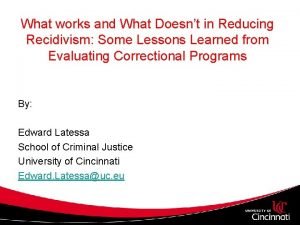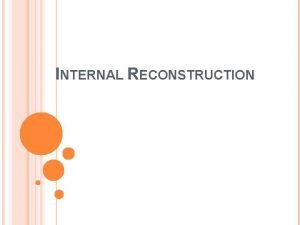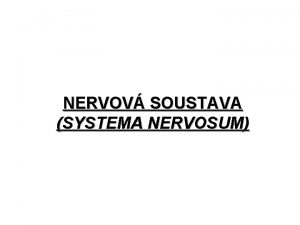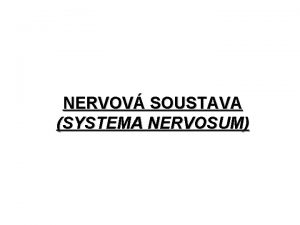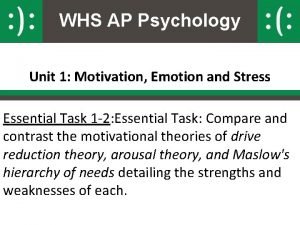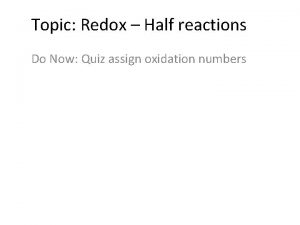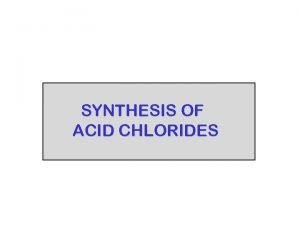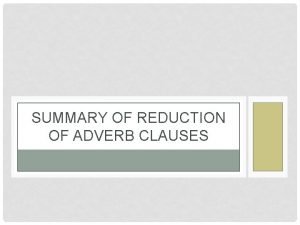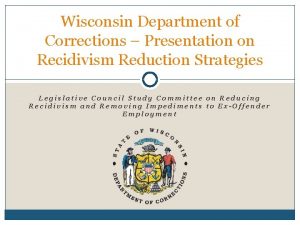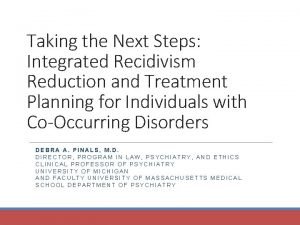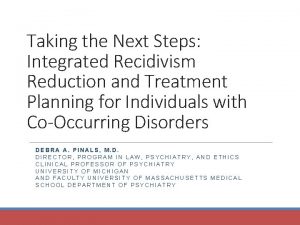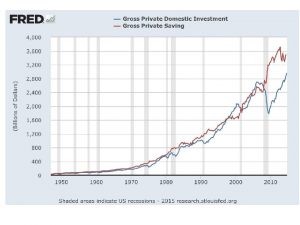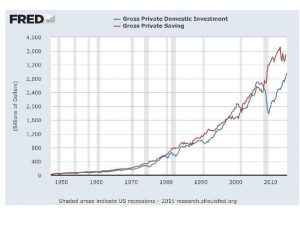Reduction of Recidivism James A Windom Capital Area












































- Slides: 44

Reduction of Recidivism! James A. Windom Capital Area Re. Entry Coalition

Creating Supportive Communities to Sustain Recovery and Reduce Recidivism for Re-Entry Populations

Overview • Offenders are Returning to your Community (what to do with them) • What is Recidivism? • Costs • Impact Nationally and Locally • Is there a systematic approach that is effective? • Reentry Models • Louisiana Prisoner Reentry Initiative (LA-PRI) • Risk, Need, Responsivity Model • Assessment • Evidence Based Practices • Implementation

At least 95 percent of the nearly 17000 incarcerated in Louisiana state prisons will be released back to their communities at some point.

• The Greater East Baton Rouge Parish receives approximately 100‐ 200 individuals from incarceration into its communities monthly. • 8. 0% of the state’s 17, 000 annual release parole population returned to Greater East Baton Rouge Parish area.

Impact: Recidivism “Although no one supports ‘coddling criminals, ’ society has a strong interest in preventing recidivism. ” -Uniform Law Comm. The three pillars of successful reintegration are gainful employment, stable housing, and family supports. Isolated from these opportunities by informal social stigmas and collateral consequences, individuals with criminal convictions are more likely to recidivate.

Why Does Recidivism Matter? Lost Productivity! 2. 2 Million Incarcerated 4. 7 Million Under Supervision 70 Million With Criminal Background Lost Revenues= $80 Billion!

Why Does Recidivism Matter? 70 Million Person Workforce! The 10 Top Fortune 500 U. S. Employers 1. Walmart = 2. 2 million 2. Mc. Donald = 420 k 3. IBM = 413 k 4. Kroger = 400 k 5. Home Depot = 371 k 6. Target = 347 k 7. UPS = 336 k 8. Berkshire Hathaway = 316 k 9. General Electric = 305 k 10. Yum Brands = 303 k Total Workforce = 5. 4 million!

Why Do Collateral Consequences Matter? 70 Million Person Workforce! The 10 Top Fortune 500 U. S. Employers 1. Walmart = 2. 2 million 2. Mc. Donald = 420 k 3. IBM = 413 k 4. Kroger = 400 k 5. Home Depot = 371 k 6. Target = 347 k 7. UPS = 336 k 8. Berkshire Hathaway = 316 k 9. General Electric = 305 k 10. Yum Brands = 303 k Total Workforce = 5. 4 million!

Collateral Consequences: A slippery slope toward recidivism Returning offenders face multiple, simultaneous barriers as they embark on the process of reestablishing their lives outside prison. • • Housing Employment Income Family issues • • Insurance Identification needs Medical concerns Treatment • • Lack of transportation No support system Education & so much more…

Recidivism: What is it? Recidivism refers to a person's relapse into criminal behavior, often after the person receives sanctions or undergoes intervention for a previous crime. Recidivism is measured by criminal acts that resulted in rearrest, reconviction or return to prison with or without a new sentence following the prisoner's release. 67% National Institute of Justice, 2014

National Statistics on Recidivism Within 3 years of release, 67. 8% of released prisoners were rearrested. Within 5 years of release, 76. 6% of released prisoners were rearrested.

Louisiana’s Statistics on Recidivism Louisiana reports that around 45 percent of Louisiana offenders will reoffend within five years of release. It is an expensive endeavor: An official estimate suggests that Louisiana spends $700 million annually on corrections.

What Affects Recidivism? What Can Community Providers do About it?

Risk, Need, Responsivity Model The concepts of Risk‐Need‐Responsivity (RNR), originally developed in the 1980 s, have gained increasing support across the nation and have recently been adopted by most Department of Corrections nation‐wide. Research indicates that the three principles can decrease the risk of recidivism for offenders when implemented correctly. The three principles are as follows: 1. Risk Principle‐ identifies WHO to target 2. Need Principle‐ identifies WHAT to target 3. Responsivity Principle‐ identifies HOW to target The RNR principles allow staff to make informed decisions on how to allocate resources to improve outcomes for the criminal justice population. Principles of Recidivism Reduction, 2014

Risk Principle Risk = How likely a person is to engage in criminal behaviors • Match level of services to level of risk • Risk does NOT refer to dangerousness or likelihood of violence • Prioritize supervision and treatment resources for higher risk clients • Higher risk clients need more intensive services • Low risk clients require little to no intervention • “If it ain’t broke, don’t fix it” Prioritize primary supervision and treatment resources for offenders who are at higher risk to re-offend. Research shows that resources that are focused on low-risk offenders tend to produce little net positive effect on recidivism rates.

Service Delivery Principles- “How You Do It” Based Primarily on Risk of Recidivism

Risk Principle tells us WHO to target … … so now what do we DO? DO

Need Principle Need = What areas in a person’s life should be targeted for intervention / supervision in order to decrease their likelihood of future criminal behavior Assess criminogenic needs and target those needs with treatment and interventions.

Criminogenic? ?

Criminogenic Needs Dynamic or “changeable” risk factors that contribute to the likelihood that someone will commit a crime • Changes in these needs / risk factors are associated with changes in recidivism. “People involved in the justice system have many needs deserving treatment, but not all of these needs are associated with criminal behavior. ” ‐ Andrews & Bonta (2006)

‘Central Eight’ Risk Factors 1. 2. 3. 4. Anti‐social Attitudes Anti‐social Peers Anti‐social Personality Pattern History of Anti‐Social Behavior These are knows as the “Big Four” Risk Factors Most highly correlated with criminal behavior among all of the factors

‘Central Eight’ Risk Factors 1. 2. 3. 4. 5. 6. Anti‐social Attitudes Anti‐social Peers Anti‐social Personality Pattern History of Anti‐Social Behavior Family / Marital Factors Lack of Achievement in Education / Employment 7. Lack of Pro‐social Leisure Activities 8. Substance Abuse

Fundamentals Returning Citizens’ Services Investment Recidivism Impact: Treatment vs. Supervision and Surveillance � � � � Intensive Supervision w/ community-based treatment Drug treatment in community Adult drug courts Employment and job training in the community Sex offender treatment in prison with aftercare Electronic monitoring Intensive supervision/surveillance Adult boot camps -16. 7% -9. 3% -8. 0% -4. 3% -7. 0% 0% Washington State Institute for Public Policy; Evidence-Based Public Policy Options to Reduce Future Prison Construction, Criminal Justice Costs, and Crime Rates; October 2006 24

Developing Effective and Sustainable Community Collaborations to Improve Returning Citizen Outcomes PART ONE A State Level Framework for Reentry Reforms to Reduce Recidivism 25

Fundamentals of the LA-PRI Implementing Evidence Based. Principals Principles Organizational EBPs � � � Skill Train Target Interventions Engage Communities Measure Performance Feedback to the Field Client Centered EBPs � � Assess Risk Assess Need Positive Reinforcement Target Interventions Crime and Justice Institute at Community Resources for Justice (2009). Implementing Evidence-Based Policy and Practice in Community Corrections, 2 nd ed. Washington, DC: National Institute of Corrections 26

Developing Effective and Sustainable Community Collaborations Developing to Improve Returning Citizen Outcomes The Transition from Prison to Community (TPC) Model National Institute of Corrections � � Developed to provide state-specific approaches to improve prisoner reentry. The Model helps guide the improvement and expansion of existing policies for states. Helps to address the complexity of the reentry process by breaking it down to three phases and seven decision points. Requires Transitional Planning and the Use of Evidence-based Practices – two “overarching paradigms”. TPC Reentry Handbook: Implementing the NIC Transition from Prison to the Community Model. Peggy Burke. Washington D. C. : U. S. Department of Justice. National Institute of Corrections, 2008 27

28

Best Practices in Transition Planning Effective Transition Plans: 3. 4. 5. Prioritize returning citizen’s goals and include attainable milestones and are built for success. Include post-release supervision requirements. Are responsive and flexible to adjust to accomplishments and set backs.

The Four Step Transition Planning Process STEP ONE Prison-based assessments of risks, needs, strengths, and environment. Ø Ø Ø Transition Planning starts in prison with a comprehensive risk/need assessment that drives the Transition Planning Process. The goal is to understand personal, situational, and historical/contextual factors behind each returning citizen’s criminal justice involvement, their risks, needs and strengths in order to mediate and manage risk and become successful in the community. The assessment should be validated and measure risk and criminogenic need but should also include multiple screenings and further assessment, as indicated, for a full range of personal history and needs.

The Four Step Transition Planning Process STEP ONE (CONT’D) Prison-based assessments of risks, needs, strengths, and environment. Ø Ø Ø The Transition Plan is built in prison to manage risk and begin to address the returning citizen’s needs for community success, including but not limited to health, mental health, family relationships, employment, and housing stability. The best Transition Plans are highly specific and include the schedule for activities. Reassessment is needed throughout the entire reentry process. Reassessment allows the team to uncover new or evolving needs and to track changes in dynamic criminogenic needs following delivery of treatment, programming, and other interventions.

The Four Step Transition Planning Process STEP TWO Form, participate in, and lead Transition Management Teams that work collaboratively. Ø Ø Throughout all three phases of reentry, transition planning and management activities are conducted by an interdisciplinary team called a Transition Management Team. The composition of the success team and the respective roles of its members will change over time, as the returning citizen completes goals, identifies new needs, and transitions through the three phases.

The Four Step Transition Planning Process STEP TWO (CONT’D) Form, participate in, and lead Transition management teams that work collaboratively. Ø Ø Generally, the team should include the returning citizen, prison staff, community supervision staff, facility and community-based service providers, and family members and/or pro-social supports. During the institutional phase prison staff may lead the team. During the reentry and community supervision phase parole officers may lead the team. During the reintegration phase human services agencies or community services providers may lead the team.

The Four Step Transition Planning Process STEP THREE Develop and implement with returning citizens, human service agencies and justice officials a Transition plan directed specifically to the level of risk and criminogenic needs. Ø Ø Ø Provide or facilitate access to programs and interventions to address risk and needs. In addition to the role members of the success team will play in delivering direct services, including assessment, treatment, and motivational enhancement, at various points, the success team will also fill a referral and brokerage role. The two complimentary roles ensure that returning citizens have access to treatment, programming, and interventions that will effectively address risk and needs. Interventions should be consistent with the principles of evidence-based practice.

The Four Step Transition Planning Process STEP FOUR Review progress and adapt plans accordingly over time, including monitoring conditions of supervision and responding appropriately to technical and criminal violations. Ø Ø Ø When indications of sliding back toward old problematic behavior patterns, a swift response to identify the problem and adjust the plan accordingly is needed. Conversely, faster than expected progress, compliance with expectations and other achievements should be acknowledged and rewarded to enhance motivation. The Transition Management Team’s focus on monitoring and adjusting the transition plan is especially important in the period immediately following return to the community when anxiety and stress require an adjustment period.

The Four Step Transition Planning Process STEP FOUR (CONT’D) Review progress and adapt plans accordingly over time, including monitoring conditions of supervision and responding appropriately to both technical and criminal violations. Ø Ø It is important that community supervision officers have the skills to distinguish between the behaviors that are affiliated with a risk of future transgression and behaviors that are more likely associated with the adjustment. The success team should be equipped with a full range of responses, including graduated levels of sanctions, that can be used to facilitate compliance and encourage success.

Evidence-Based Practices Lead to Better Outcomes Most Effective: • Cognitive Processing • Cognitive Behavioral (Social Skills, Behavioral Management, etc. ) • Therapeutic Communities (TC) Moderately Effective: • Motivational Interviewing • Moral Reasoning • Emotional Skills • 12 Step with Curriculum Least Effective: • Education (Psycho‐Social) • Non‐Directive Counseling • Intensive Supervision • Contingency Management/Token Economies • Drug Courts • RNR Supervision • In‐Prison TC with Aftercare • TASC • DTAP (Diversion to TX, 12 Month Residential) • Treatment with Sanctions (e. g. Break the Cycle, Seamless System, etc. ) • Boot Camp • Case Management • Incarceration Principles of drug abuse treatment for criminal justice populations: A research based guide

Evidence-based Cognitive Behavioral Programs to Reduce Recidivism • Moral Reconation Therapy (MRT) is a cognitive‐behavioral program for substance abuse treatment and for criminal justice offenders. MRT addresses beliefs and reasoning. It is a systematic, step‐by‐step group counseling treatment approach for treatment‐resistant clients. The program is designed to alter how clients think and make judgments about what is right and wrong. • Thinking for a Change 4. 0 (T 4 C) is an integrated cognitive behavioral change program. T 4 C uses a combination of approaches to increase offenders’ awareness of themselves and others by integrating cognitive restructuring, social skills, and problem solving skills. • The Reasoning & Rehabilitation (R&R) program is an cognitive ‐behavioral program for teaching the cognitive skills, social skills and values that are required for prosocial competence.

What Doesn’t Work! Famous Programs Based On Flawed Theories/Models Scared Straight – deterrence theory; “make them fear prison. ” • o Nearly every study over the past 25 years has found dismal results, many even showing higher recidivism rates for Scared Straight participants. Has been characterized as criminal justice malpractice. Drug Abuse Resistance Education (DARE) – didactic model; “kids don’t know drugs are bad for them. ” • o Most studies have found neutral effects for DARE. More recent versions of DARE, based upon cognitive‐behavioral principles, have been more promising Sheriff Joe Arpaio’s (Maricopa County Jail, Arizona) Tent Cities and Chain Gangs – more deterrence theory; “make them hate prison. ” • o By the jail’s own admission, its recidivism rate exceeds 60 percent. Latessa, What Works and What Doesn’t in Reducing Recidivism: Applying the Principles of Effective Intervention to Offender Reentry

The Challenges Of Implementing Effective Interventions • Requires a dedicated commitment to change by managers, line staff, and everyone in between - Not just in corrections agencies, but in all service delivery agencies • Requires an increased emphasis on accountability for our work – individual and collective • Requires us to reconsider current practices and let go of the “that’s always how we’ve done it” philosophy • Requires us to confront and address resistance

Important Considerations • Offender assessment is the engine that drives effective programs and helps you know who/what to target • Design programs around empirical research (helps you know how to effectively target offenders) • Program integrity makes a difference • Service delivery, training/supervision of staff, support for program, QA, evaluation, track results • FIDELITY, FIDELITY

Questions? Bibliography and/or copy of presentation available upon request. Email: james. windom@caparc. org Point of view or opinions in this presentation are those of the author and do not represent the official position or policies of the Louisiana Department of Public Safety and Corrections. Information given was based from recent research findings provided in the correlating Bibliography.

Resources D. A. Andrews and James Bonta, “Color. Plot Profile Form for Men, ” The Level of Service Inventory ‐ Revised: U. S. Norms, (North Tonawanda: Multi‐Health Systems, Inc. , 2003). Don Stemen, Vera Institute of Justice, Reconsidering Incarceration: New Directions for Reducing Crime 13‐ 14 (2007). Durose, Matthew R. , Alexia D. Cooper, and Howard N. Snyder, Recidivism of Prisoners Released in 30 States in 2005: Patterns from 2005 to 2010 (pdf, 31 pages), Bureau of Justice Statistics Special Report, April 2014, NCJ 244205. Koetzle, D. & Skinner, B. (2014. ) “Recidivism Reduction Training: Strategies for Promoting Staff Safety and Public Safety in Rhode Island. ” Presentation at the Rhode Island Department of Corrections Recidivism Reduction Training, Cranston, RI, June 3 & 4, 2014. "National Information on Offender Assessments Part II. " Illinois Risk, Assets and Needs Assessment Task Force. Vera Institute of Justice, Center on Sentencing and Corrections, 27 May 2010. Web. 15 Mar. 2017. National Institute of Justice. "Recidivism. " National Institute of Justice, 17 June 2014. Web. 1 Mar. 2017.

Resources Cont. Latessa, E. J. (n. d. ) “What works and what doesn’t in reducing recidivism: applying the principles of effective intervention to offender reentry” Power. Point Presentation. University of Cincinnati, OH. Mc. Collister, K. E. , French, M. T. , and Fang, H. (2010). The Cost of Crime to Society: New Crime‐Specific Estimates for Policy and Program Evaluation. Drug and Alcohol Dependence, 108, 98‐ 109 National Institute of Corrections. "Transition from Prison to Community (TPC). "NICIC. gov: Transition from Prison to Community (TPC). National Institute of Corrections, 2010. Web. 15 Mar. 2017. National Institute on Drug Abuse. (2006). Principles of drug abuse treatment for criminal justice populations: A research based guide. Rockville, MD: National Institutes of Health. Principles of Recidivism Reduction (2014). Retrieved June 5 th, 2014 from: http: //csgjusticecenter. org/reentry/principles‐of‐recidivism‐reduction. Stephanie Lee, Steve Aos, Elizabeth Drake, Annie Pennucci, Marna Miller, Laurie Anderson, “Return on Investment: Evidence‐Based Options to Improve Statewide Outcomes, ” (Olympia: Washington State Institute for Public Policy, April 2012); Warren, R. , and Crime and Justice Institute. 2007. Evidence‐Based Practice to Reduce Recidivism: Implications for State Judiciaries. Washington, DC: U. S. Department of Justice, National Institute of Corrections.
 What works and doesn't in reducing recidivism download
What works and doesn't in reducing recidivism download Recidive adalah
Recidive adalah Carolina windom
Carolina windom What is internal reconstruction
What is internal reconstruction Kinds of share capital
Kinds of share capital Scsi unit fbi
Scsi unit fbi Clay lawson and russell odom
Clay lawson and russell odom Net working capital refers to which of the following
Net working capital refers to which of the following Difference between capital reserve and reserve capital
Difference between capital reserve and reserve capital Multinational capital structure
Multinational capital structure Difference between capital reserve and reserve capital
Difference between capital reserve and reserve capital Basle ii
Basle ii Regulatory capital vs economic capital
Regulatory capital vs economic capital Constant vs variable capital
Constant vs variable capital Multinational cost of capital and capital structure
Multinational cost of capital and capital structure Capital allocation line vs capital market line
Capital allocation line vs capital market line Lateral area prism
Lateral area prism Cobol area a and area b
Cobol area a and area b Cobol area a and area b
Cobol area a and area b Volume and surface area of cone
Volume and surface area of cone What is the lateral area
What is the lateral area Cobol area a and area b
Cobol area a and area b Gastrulation in fish
Gastrulation in fish Area nervina area radicularis
Area nervina area radicularis Surfce area
Surfce area Posterior palatal seal landmarks
Posterior palatal seal landmarks Find the lateral area and surface area of each prism
Find the lateral area and surface area of each prism Lateral area
Lateral area Filip barinka
Filip barinka Systema nervosum periphericum
Systema nervosum periphericum What is lateral area
What is lateral area How to find the lateral area of a hexagonal prism
How to find the lateral area of a hexagonal prism Wsjf score
Wsjf score Arousal theory ap psychology
Arousal theory ap psychology Hull theory of learning
Hull theory of learning Parvin's method
Parvin's method Which equation represents an oxidation-reduction reaction
Which equation represents an oxidation-reduction reaction Reduction translation technique
Reduction translation technique Oxidation-reduction quiz
Oxidation-reduction quiz Which equation represents an oxidation-reduction reaction
Which equation represents an oxidation-reduction reaction Pengertian dari drive reduction theory tentang motivasi
Pengertian dari drive reduction theory tentang motivasi Dibal h reduction
Dibal h reduction Reducing adverbial clauses
Reducing adverbial clauses Difference between sulphur and vat dyes
Difference between sulphur and vat dyes What is this
What is this
